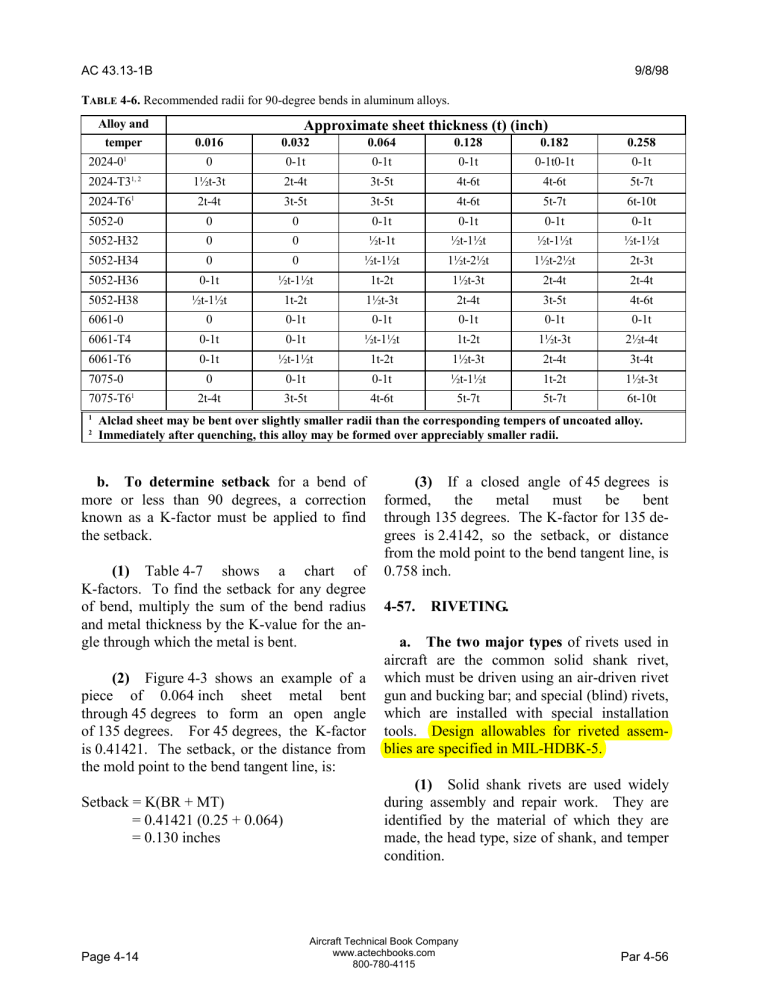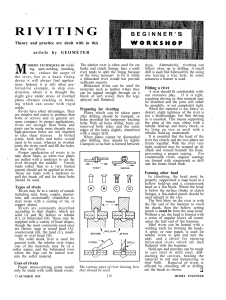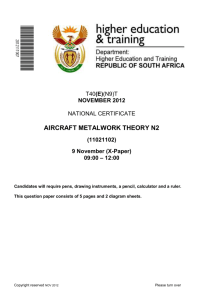Approximate sheet thickness (t) (inch)
advertisement

AC 43.13-1B 9/8/98 TABLE 4-6. Recommended radii for 90-degree bends in aluminum alloys. Alloy and temper 1 2024-0 1, 2 Approximate sheet thickness (t) (inch) 0.016 0.032 0.064 0.128 0.182 0.258 0 0-1t 0-1t 0-1t 0-1t0-1t 0-1t 2024-T3 1½t-3t 2t-4t 3t-5t 4t-6t 4t-6t 5t-7t 2024-T61 2t-4t 3t-5t 3t-5t 4t-6t 5t-7t 6t-10t 5052-0 0 0 0-1t 0-1t 0-1t 0-1t 5052-H32 0 0 ½t-1t ½t-1½t ½t-1½t ½t-1½t 5052-H34 0 0 ½t-1½t 1½t-2½t 1½t-2½t 2t-3t 5052-H36 0-1t ½t-1½t 1t-2t 1½t-3t 2t-4t 2t-4t 5052-H38 ½t-1½t 1t-2t 1½t-3t 2t-4t 3t-5t 4t-6t 0 0-1t 0-1t 0-1t 0-1t 0-1t 6061-T4 0-1t 0-1t ½t-1½t 1t-2t 1½t-3t 2½t-4t 6061-T6 0-1t ½t-1½t 1t-2t 1½t-3t 2t-4t 3t-4t 0 0-1t 0-1t ½t-1½t 1t-2t 1½t-3t 2t-4t 3t-5t 4t-6t 5t-7t 5t-7t 6t-10t 6061-0 7075-0 1 7075-T6 1 2 Alclad sheet may be bent over slightly smaller radii than the corresponding tempers of uncoated alloy. Immediately after quenching, this alloy may be formed over appreciably smaller radii. b. To determine setback for a bend of more or less than 90 degrees, a correction known as a K-factor must be applied to find the setback. (1) Table 4-7 shows a chart of K-factors. To find the setback for any degree of bend, multiply the sum of the bend radius and metal thickness by the K-value for the angle through which the metal is bent. (2) Figure 4-3 shows an example of a piece of 0.064 inch sheet metal bent through 45 degrees to form an open angle of 135 degrees. For 45 degrees, the K-factor is 0.41421. The setback, or the distance from the mold point to the bend tangent line, is: Setback = K(BR + MT) = 0.41421 (0.25 + 0.064) = 0.130 inches Page 4-14 (3) If a closed angle of 45 degrees is formed, the metal must be bent through 135 degrees. The K-factor for 135 degrees is 2.4142, so the setback, or distance from the mold point to the bend tangent line, is 0.758 inch. 4-57. RIVETING. a. The two major types of rivets used in aircraft are the common solid shank rivet, which must be driven using an air-driven rivet gun and bucking bar; and special (blind) rivets, which are installed with special installation tools. Design allowables for riveted assemblies are specified in MIL-HDBK-5. (1) Solid shank rivets are used widely during assembly and repair work. They are identified by the material of which they are made, the head type, size of shank, and temper condition. Aircraft Technical Book Company www.actechbooks.com 800-780-4115 Par 4-56 AC 43.13-1B 9/8/98 FIGURE 4-4. Rivet identification and part number breakdown. FIGURE 4-3. Methods of determining setback for bends other than 90 degree. (4) Countersunk head rivets (MS20426 supersedes AN426 100-degree) are used where a smooth finish is desired. The 100-degree countersunk head has been adopted as the standard in the United States. The universal head rivet (AN470 superseded by MS20470) has been adopted as the standard for protruding-head rivets, and may be used as a replacement for the roundhead, flathead, and brazier head rivet. These rivets can also be purchased in half sizes by designating a “0.5” after the main length (i.e., MS20470 AD4-3.5). Page 4-16 b. Replace rivets with those of the same size and strength whenever possible. If the rivet hole becomes enlarged, deformed, or otherwise damaged; drill or ream the hole for the next larger size rivet. However, make sure that the edge distance and spacing is not less than minimums listed in the next paragraph. Rivets may not be replaced by a type having lower strength properties, unless the lower strength is adequately compensated by an increase in size or a greater number of rivets. It is acceptable to replace 2017 rivets of 3/16 inch diameter or less, and 2024 rivets of 5/32 inch diameter or less with 2117 rivets for general repairs, provided the replacement rivets are 1/32 inch greater in diameter than the rivets they replace. Aircraft Technical Book Company www.actechbooks.com 800-780-4115 Par 4-57 9/27/01 AC 43.13-1B CHG 1 c. Rivet edge distance is defined as the distance from the center of the rivet hole to the nearest edge of the sheet. Rivet spacing is the distance from the center of the rivet hole to the center of the adjacent rivet hole. Unless structural deficiencies are suspected, the rivet spacing and edge distance should duplicate those of the original aircraft structure. If structural deficiencies are suspected, the following may be used in determining minimum edge distance and rivet spacing. (1) For single row rivets, the edge distance should not be less than 2 times the diameter of the rivet and spacing should not be less than 3 times the diameter of the rivet. (2) For double row rivets, the edge distance and spacing should not be less than the minimums shown in figure 4-5. (3) For triple or multiple row rivets, the edge distance and spacing should not be less than the minimums shown in figure 4-5. d. The 2117 rivets may be driven in the condition received, but 2017 rivets above 3/16 inch in diameter and all 2024 rivets are to be kept packed in dry ice or refrigerated in the “quenched” condition until driven, or be reheat treated just prior to driving, as they would otherwise be too hard for satisfactory riveting. Dimensions for formed rivet heads are shown in figure 4-6(a), together with commonly found rivet imperfections. e. When solid shank rivets are impractical to use, then special fasteners are used. Special fastening systems used for aircraft construction and repair are divided into two types, special and blind fasteners. Special fasteners are sometimes designed for a specific purpose in an aircraft structure. The name “special fasteners” refers to its job requirement and the tooling needed for installation. Use of Par 4-57 special fasteners may require an FAA field approval. f. Blind rivets are used under certain conditions when there is access to only one side of the structure. Typically, the locking characteristics of a blind rivet are not as good as a driven rivet. Therefore, blind rivets are usually not used when driven rivets can be installed. Blind rivets shall not be used: (1) in fluid-tight areas; (2) on aircraft in air intake areas where rivet parts may be ingested by the engine, on aircraft control surfaces, hinges, hinge brackets, flight control actuating systems, wing attachment fittings, landing gear fittings, on floats or amphibian hulls below the water level, or other heavily-stressed locations on the aircraft; CAUTION: For metal repairs to the airframe, the use of blind rivets must be specifically authorized by the airframe manufacturer or approved by a representative of the FAA. (3) Self plugging friction-lock cherry rivets. This patented rivet may be installed when there is access to only one side of the structure. The blind head is formed by pulling the tapered stem into the hollow shank. This swells the shank and clamps the skins tightly together. When the shank is fully upset, the stem pulls in two. The stem does not fracture flush with the rivet head and must be trimmed and filed flush for the installation to be complete. Because of the friction-locking stem, these rivets are very sensitive to vibrations. Inspection is visual, with a loose rivet standing out in the standard “smoking rivet” pattern. Removal consists of punching out the friction- Aircraft Technical Book Company www.actechbooks.com 800-780-4115 Page 4-19 (and 4-19a) AC 43.13-1B 9/8/98 FIGURE 4-5. Rivet hole spacing and edge distance for single-lap sheet splices. Page 4-20 Aircraft Technical Book Company www.actechbooks.com 800-780-4115 Par 4-57 9/27/01 AC 43.13-1B CHG 1 FIGURE 4-6. Riveting practice and rivet imperfections. Par 4-57 Aircraft Technical Book Company www.actechbooks.com 800-780-4115 Page 4-21 AC 43.13-1B 9/8/98 (b) The Bulbed Cherrylock rivets are available in two head styles: universal and 100° countersunk. Their lengths are measured in increments of 1/16 inch. It is important to select a rivet with a length related to the grip length of the metal being joined. (c) The Bulbed Cherrylock rivet can be installed using a G35 cherry rivet hand puller or a pneumatic Bulbed Cherrylock pulling tool. FIGURE 4-7. Self plugging friction-lock Cherry rivets. (5) Bulbed Cherrylock Rivets. One of the earlier types of mechanical-lock rivets developed were Bulbed Cherrylock blind rivets. These blind rivets have as their main advantage the ability to replace a solid shank rivet size for size. (See figure 4-8.) (a) A Bulbed Cherrylock consists of three parts; a rivet shell, a puller, and a lockring. The puller or stem has five features which are activated during installation; a header, shank expanding section, lockring indent, weak or stem fracture point, and a serrated pulling stem. Carried on the pulling stem, near the manufactured head, is the stem lockring. When the rivet is pulled the action of the moving stem clamps together the sheets of metal and swells the shank to fill the drilled hole. When the stem reaches its preset limit of travel, the upper stem breaks away (just above the lockring) as the lockring snaps into the recess on the locking stem. The rough end of the retained stem in the center on the manufactured head must never be filed smooth, because it will weaken the strength of the lockring and the center stem could fall out. (See figure 4-8.) Page 4-22 (6) The CherryMax (see figure 4-9) rivet uses one tool to install three standard rivet diameters and their oversize counterparts. This makes the use of CherryMax rivets very popular with many small general aviation repair shops. CherryMax rivets are available in four nominal diameters 1/8, 5/32, 3/16, and 1/4 inch and three oversized diameters. CherryMax rivets are manufactured with two head styles, universal and countersunk. The CherryMax rivets consists of five parts; bulbed blind header, hollow rivet shell, locking (foil) collar, driving anvil, and pulling stem. The blind bulbed header takes up the extended shank and forms the bucktail on a CherryMax rivet stem. Rivet sleeves are made from 5056 aluminum, monel, and INCO 600. The stems are made from alloy steel, CRES, and INCO X-750 stem. CherryMax rivets have an ultimate shear strength ranging from 50 KSI to 75 KSI. (7) An Olympic-Lok (see figure 4-10) rivet is a light three-piece mechanically locked, spindle-type blind rivet. It carries its stem lock integral to the manufactured head. While installing, the lockring is pressed into a groove on the pulling stem just as the rivet completes drawing the metal together. After installation is completed, never file the stem of an Olympic-Lok rivet, because it will weaken the lockring attachment. The Olympic-Lok fastener is available in three head styles: Aircraft Technical Book Company www.actechbooks.com 800-780-4115 Par 4-57


